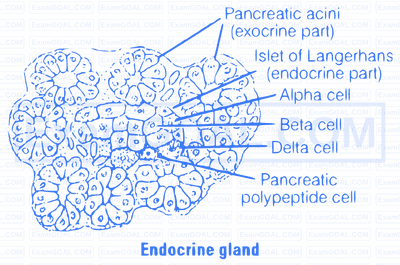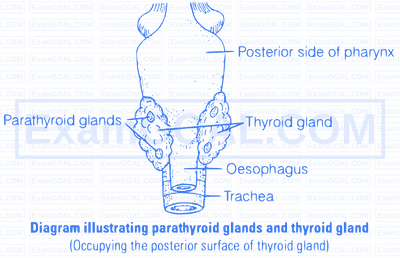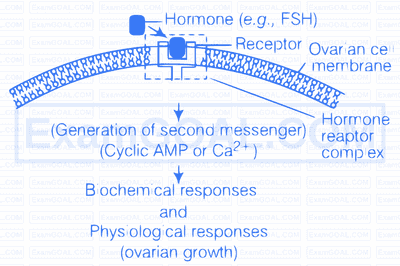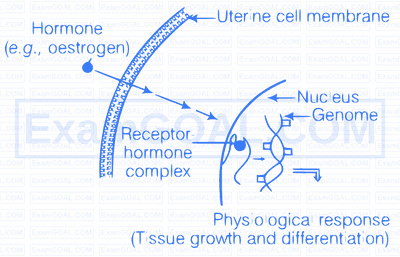A sample of urine was diagnosed to contain high content of glucose and ketone bodies. Based on this observation, answer the following
(a) which endocrine gland and hormone is related to this condition?
(b) name the cells on which this hormone acts
(c) what is the condition called and how can it rectified?
(a) The pancreas is associated with this condition and the related hormone is insulin. The pancreas consists of 'islets of Langerhans. The two main type of cells in islets of Langerhans are $\alpha$-cells and $\beta$-cells. $\alpha$-cells secrete glucagon while $\beta$-cell secrete insulin.
Insulin is a peptide hormone, which plays a major role in the regulation of glucose homeostasis. It decreases the level of glucose in blood by increasing the rate at which glucose is transported out of blood and into the cell.
When insulin is dysfunctional or not produced adequately glucose uptake is hampered" and hence glucose appear in urine along with ketone bodies.

(b) Insulin hormone mainly acts on hepatocytes (liver cells) and adipocytes (cells of adipose tissue) and enhances cellular glucose up take and utilisation.
(c) Prolonged hyperglycemic condition leads to a complex disorder called diabetes mellitus which is associated with loss of glucose through urine and formation of harmful compounds known as ketone bodies due to protein metabolism.
Diabetic patients are successfully treated with insulin therapy. It lowers the blood glucose levels and give relief to the patients.
The endocrine glands and hormones that are responsible for maintaining calcium homeostasis, are thyroid and parathyroid glands and their associated hormones are calcitonin and Parathyroid Hormone (PTH).
(i) Parathyroid glands are the glands developed from the endoderm of the embryo. The cells of parathyroid glands are of two types, i.e., chief cells and oxyphil cells. The chief cells of the parathyroid glands secrete parathyroid hormone (PTH).
This hormone (PTH) is involved in regulating calcium and phosphate balance between the blood and other tissue. It mobilises the release of calcium into the blood from bones. PTH increases calcium reabsorption by the body organs like intestine and kidneys.
(ii) Thyroid gland is the largest endocrine gland located anterior to the thyroid cartilage of the larynx in the neck. This gland plays a vital role in maintaining calcium homeostasis. It releases thyrocalcitonin hormone produced by the parafollicular cells, also called ' $C$ ' cells.
This hormone is secreted when the calcium level in blood gets high. It is a 32 amino acid peptide hormone that lowers the calcium level by suppressing release of calcium ions from the bones. Thus, calcitonin has an action opposite to that of the parathyroid hormone on calcium homeostasis.

Differences between the mechanism of action of a peptide and a steroid hormone are as follows
| Peptide Hormone Action | Steroid Hormone Action |
|---|---|
| Peptide hormones interact with membrane bound receptors. |
They interact with intracellular receptors to form hormone receptor complex |
| They generate second messengers (e.g. cyclic AMP, $\mathrm{IP}_3, \mathrm{Ca}^{2+}$, etc.) |
They regulate gene expression or chromosomes function by the interaction of hormone receptor complex with the genome. |
| The second messengers regulate cellular metabolism. e.g. oxytocin insulin, glucagon, vasopressin. etc, |
Cumulative biochemical actions results in physiological and development effects. e.g., cortisol, testosterone, estrogen and progesterone. |
 |
 |
Hypothalamus is a very small but extremely important part of the diencephalon that is involved in the mediation of endocrine, autonomic and behavioural function.
It contains several groups of neurosecretory cells called nuclei which produce hormones. Hypothalamus provides anatomical connection between the nervous and endocrine system. It controls the release of major hormones by the hypophysis which are summarised below
(i) Adrenocorticotrophic Releasing Hormone (ARH) It stimulates the anterior lobe of pituitary gland to secrete Adrenocorticotropic Hormone (ACTH). ACTH stimulates the synthesis and secretion of steroid hormones called glucocorticoids by adrenal glands.
(ii) Thyrotropin Releasing Hormone (TRH) It stimulates the anterior lobe of pituitary gland to release Thyroid Stimulating Hormone (TSH).
(iii) Growth Hormone Releasing Hormone It stimulates the anterior lobe of the pituitary gland to release growth hormone or somatostatin.
(iv) Gonadotropin Releasing Hormone It stimulates the anterior lobe of the pituitary gland to release gonadotropic hormones (FSH and LH).
(v) Prolactin Releasing Hormone (PRH) It stimulates the anterior lobe of the pituitary gland to secrete prolactin.
(vi) MSH Releasing Hormone It stimulates the intermediate lobe of the pituitary gland to secrete Melanocyte Stimulating Hormone (MSH)
These hormones released from hypothalamus are involved in the process like temperature regulation, control of water balance in body, sexual behaviour and reproduction, control of daily cycles in physiological state, behaviour and mediation of emotional responses. Hence, hypothalamus is called as super master endocrine gland of body.